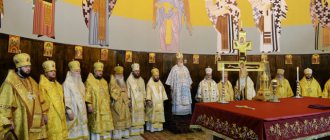“The Presbyterian Church - what is it?” someone will ask, another will categorically state that it is a sect, and a third will suggest that this is the name of the Church of England. It seems as if this church organization is somewhere far away and should not interest us.
But Presbyterianism also exists in Russia. This is a centuries-old Christian tradition, the peculiarities of the doctrine of which are useful for a devout person to know.
We live next to our brothers in faith, and understanding how we differ from each other is useful for constructive dialogue between faiths.
Presbyterianism is not a sect, but one of the Protestant branches of Christianity
First, about the main thing: Presbyterianism is not a sect or a religion alien to us, but simply a Protestant movement of Christianity. There are many like him. And the reason for their appearance lies not in theological, but in political and administrative disagreements.
Over the years, different branches of Christianity have developed differences in their views on the Holy Scriptures, on liturgical practice, etc.
This makes it difficult to put an “equal” sign between the movements of one religion, but still this is not enough to recognize Catholicism, Protestantism or Orthodoxy as a heresy in relation to another confession.
A sect is an organization based on a traditional religion, which fundamentally diverges from it in doctrine and is prohibited by law in the territory of a particular country.
Presbyterianism is a type of Calvinism
Now about the definitions.
In a broad sense, Presbyterianism is a reformed church, or more precisely, a Calvinist one. This name comes from the name of John Calvin, a preacher and theologian from France, whose views formed the basis of a number of Protestant movements.
John Calvin formulated the ideological basis of Presbyterianism - Calvinism
He rejected many church foundations and traditions, considered them unnecessary, and disdained Christian mysticism. But his main idea is: God is always in charge in everything, that is, he has sovereignty.
This leads to the conclusion about the helplessness and futility of a person to change anything in fate and the world.
Calvinism includes the following movements of Christianity:
- reformism;
- Congregationalism;
- Presbyterianism.
Also, the views of John Calvin influenced other schools of Protestantism:
- baptism;
- Puritanism;
- Pentecostalism;
- Methodism;
- evangelical Christians.
In addition to these directions, it is also necessary to mention the Mormons: their teaching also shows features of Calvinism.
At the heart of Calvinism, and therefore Presbyterianism, is the idea of reinterpreting the Holy Scriptures, its re-study, from which new conclusions are drawn, often contradicting traditional interpretations.
Doctrine
Sculpture in front of the Presbyterian Church of Rio de Janeiro, depicting the first Protestant Holy Supper in Brazil.
An important characteristic of the Presbyterian Church is its doctrine. As mentioned earlier, the teachings of this religious organization are based on the Bible, and Calvin and others are the main commentators. The assembly, established at Westminster in 1643, accepted Calvinist doctrine and reflected it in the Large Catechism and the Confession of Faith. The doctrine is primarily based on the inspiration of Scripture, the deity of Jesus Christ, the atonement, regeneration, repentance, justification by faith alone, sanctification, adoption, the resurrection of Jesus Christ, his ministry of intercession, and his second coming.
Presbyterian doctrine emphasizes the exaltation of God, his sovereignty, and what is called double predestination (God's plan by which he chose his children before the foundation of the world). This latter doctrine is taught in many Presbyterian churches more moderately and minutely than in the writings of Calvin. Other historical documents that compile the teachings of the Reformed churches are the Heidelberg Catechism (1563) and the Second Helvetian Confession of Faith (1566). Also noteworthy today is the Confession of the Presbyterian Church of the United States, adopted in 1967. The Presbyterian Church accepts only two sacraments instituted by Jesus Christ: Baptism and Holy Communion.
Presbyterians believe that baptism is the sacrament instituted by Jesus Christ by which a person enters into the Church, and is the sign of the covenant seal of grace, his new birth and the forgiveness of sins. Water is used as the external element and the person is baptized in the name of the Father, Son and Holy Spirit, since baptism is used only once in a lifetime. Most Presbyterians practice baptism by sprinkling, that is, by wetting only the head of the person being baptized, without the need to immerse the person. Another minority sector in the movement baptizes believers old enough to make a profession of faith, and includes their children in the Covenant with God through covenantal dedication, and any baptism performed other denominations of Reformed Evangelical Protestant Christians are accepted (baptisms belonging to the Catholic Church and the Orthodox Church are also recognized). Baptism also applies to children. [ 1 ] The Lord's Supper or Lord's Supper is another sacrament and sacrament of the Presbyterians. This is the memory of the sacrifice made by Jesus Christ on the cross of Calvary. The outer elements are bread and wine, which represent the body and blood of Christ respectively. Therefore, Presbyterians do not believe in the Catholic doctrine of transubstantiation.
In the 16th century, Presbyterianism became the official religion of Scotland.
Presbyterianism arose in the mid-16th century against the backdrop of the Protestant Revolution. The main popularizer of this teaching was John Knox, who was deeply imbued with the ideas of his teacher, Calvin.
John Knox - theologian and one of the most prominent popularizers of Presbyterianism
The Protestants achieved their goal - they defended the idea that a church or any other structure is not needed for a person to communicate with God.
The Lord is inside every person - and this, if not devalues, then significantly reduces the role of religious organizations as a mediator.
The establishment of Presbyterianism was influenced by John Knox, a student of Calvin.
Rejecting the traditional church, John Knox set about organizing his own.
The resonance of Presbyterianism was so powerful that after the overthrow of Mary Stuart in 1567, it was this Christian branch that became official in Scotland.
Presbyterianism is not only a creed, but also a form of church organization
A pause in history is appropriate here. It must be said why this Christian branch stood out so much from the rest.
The traditional church is based on a hierarchical form of government. This is our heritage since the time of Moses and the Old Testament prophets. Traditional Christianity is a religion of individuals.
There is the personality of Jesus Christ, followed by the personalities of his disciples, the apostles, followed by the Roman pantiffs and Byzantine patriarchs.
In Presbyterianism, the Church and parishes are governed by councils, not by clergy.
Each bishop is a direct successor to the apostolic tradition and the head of certain “departments”, dioceses, within the whole structure.
Every monastery and parish also has its own abbot. Therefore, in traditional Christianity, sole power is always concentrated in the hands of an individual.
Not so in Presbyterianism.
The Christian community, from the point of view of Presbyterians, is the best form of government in the Church
Calvin drew attention to the fact that in the New Testament we are talking about Christian communities, which means that the model of governance there has probably always been group-based. It is not so important whether to call the top a synod, an assembly or a council - the main thing is that the ruling function is carried out by several people.
And if you are building a “correct” church, then it is worth reproducing the New Testament management scheme.
By the way, this idea was developed more deeply in congregationalism. There, even the parish of the temple is governed by an autonomous assembly, which does not depend on higher church authorities.
In Presbyterianism, the vertical structure of church power is more pronounced.
Also interesting are the following features of management organization:
- “Elders” are elected to the councils (service terms vary up to lifelong);
- there is a pastor, but he is not a leader, but the chairman of the council;
- the pastor conducts the sacraments and preaches;
- the pastor may also be a member of a higher council.
At the head of the entire Presbyterian Church is the main council (general assembly or synod). It consists of chairmen of groups lower in the hierarchy.
Civil War and Interregnum
See also: History of the Puritans under Charles I and Religion during the Interregnum
English Presbyterianism itself dates back to the turbulent year of 1641, with the execution of the Earl of Stafford, the imprisonment of twelve bishops, the publication of the Grand Remonstrance, and, most importantly, the beginning of a great debate in Parliament and beyond on the issue of church government. On 11 December 1640, 15,000 Londoners presented the Root and Branch Petition to Parliament, which led to the Westminster Meeting of Divines. The meeting reported in July 1645. Later that year, Parliament passed an ordinance establishing in each parish a "congregational assembly", consisting of ruling elders, elected by the minister, and members of the congregation, meeting weekly. In practice, several parish assemblies were created. The execution of King Charles I in 1649 frightened the Presbyterians and led to a serious rift between them and the Independents. The English Presbyterians became representatives of those Puritans who still cherished further reformation in the church, but were unwavering in their fundamental loyalty. Crown.[4]
Andrew Melville abolished the institution of bishopric in Scotland
The next important figure in the history of Presbyterianism is Andrew Melville. He taught and was interested in philosophy, theology and poetry. The very tips discussed in the previous section are his invention.
He believed that each parish should have autonomy, and the Church itself should not depend on the state.
Andrew Melville's enthusiasm is admirable. This activist managed to defend the independence of the Church and expel the bishops from Scotland.
Since then, the Church of Scotland has included over a million believers. It should not be confused with the religious organization called the Free Presbyterian Church of Scotland.
See also the article What kind of faith do Armenians have?
Presbyterianism spread to Europe and North America
Gradually, Presbyterianism began to spread to different countries.
England. The penetration of a new tradition into the south of the island is natural and expected. But Presbyterianism was unable to gain a dominant position among the churches there. The English soil turned out to be too intractable, so that in the end two compromise-transformed movements took root on it:
- Evangelical Presbyterian Church of England and Wales;
- United Reformed Church.
Ireland. This country at one time suffered greatly from its neighbors. Consider the fact that Ireland is the only European colony country. In the 17th century, many people from Scotland moved here, bringing with them a new Christian tradition - Presbyterianism.
The Irish had to come to terms with it, and then they got used to it. Today the Presbyterian Church is the second largest in Northern Ireland.
Presbyterianism flourishes in North America and Ireland.
North America. After the discovery of America, many Europeans set out to conquer new lands. Among them were enough Presbyterians who founded schools of Presbyterian ideology in North America in 1973. But these currents did not form a single structure, since they differed from each other in small details.
In 1925, the United Church of Canada arose, which absorbed many Presbyterian churches
See also the article Church of England
external reference
- Wikimedia Commons has a media section on Presbyterianism
. - History of the Presbyterian Church in Argentina through its pastors
- Presbyterian Christian Church in Spain
| authoritative control |
|
- Datos: Q178169
- Multimedia: Presbyterianism
Relations between Orthodoxy and Presbyterianism have not yet been established
Presbyterianism entered Russia en masse during the reign of Peter I, together with foreign employees, mostly Dutch.
Then the tolerant attitude towards foreigners and their beliefs was at the forefront, so there is no need to talk about significant conflicts between representatives of faiths.
Officially, the Presbyterian Church in Russia arose in 1860 and has since spread throughout the country.
Self-study of the Holy Scriptures is very important for Presbyterians
The relationship between Orthodoxy and Presbyterianism is ambiguous. On the one hand, there are many Christians who remember the parable of Jesus Christ about the Good Samaritan and treat with love everyone who is different from them.
On the other hand, in the media and in sermons, Orthodox priests often allow themselves to attack any Protestants. They are even called heretics, which is unfair.
And in addition, not so long ago, US Presbyterians announced that from now on they would not ban same-sex marriage, which caused a wave of negativity in the Orthodox world.
Restoration and post-restoration
See also: History of the Puritans since 1660
After the Restoration of the monarchy under King Charles II, and out of the episcopal (headed by a bishop) system in the Church of England, Anglican priests who favored a Presbyterian state found themselves in a dilemma. In 1662 the Act of Uniformity required them to adopt the Book of Common Prayer as a whole, as well as the requirement of episcopal ordination. The ministers who disagreed, about 2,000 of them, were removed from their posts (and generally from their homes) on St. Bartholomew's Day, in what became known as the Great Blowout. More than a century of persecution followed, including further Acts of Parliament such as Lord Hardwicke's Marriage Act 1753.
The Church of England found it difficult to fill the vacancies caused by the expulsion of so many ministers. In some cases, ministers continued to baptize, marry, and preach in the parish church completely illegally. In general, the exiled ministers continued to preach to scattered congregations, using now unused light chapels (most of which were built with private donations) and from their own homes. However, by the end of the seventeenth century, the Church of England reclaimed these chapels of ease, and dissident congregations began to build their own chapels.
Apart from Quaker meetings, English Dissenters called themselves "Independents" or "Presbyterian". The "Independents", who may have a Calvinist or Baptist Creed, considered themselves exclusive and distinct from the parish church. On the other hand, the Presbyterians, although each congregation was as independent and autonomous as any independent chapel, used the name "Presbyterians" because they considered the doors of their chapels to be open to all members of the parish; or at least all members of the parish of good character. Essentially, they considered each chapel to be just another parish church. It was this attitude that initially caused particular hostility towards Presbyterians on the part of some Anglicans, who considered them schismatics, actively seeking to divide the Church in England.[5][6][7] However, outwardly there was initially little difference between the "Independents" and the "Presbyterians", except that they received financial assistance from the boards of the Independent and Presbyterian foundations respectively.
The exclusivity of independent congregations tended to perpetuate a conservatism in Christian doctrine that kept congregations orthodox and Calvinistic. The more open attitude of Presbyterian congregations led them to appoint ministers with a more liberal point of view, which, among other things, such as the training of their ministers in Dissenting academies, led to the growth of dissent in Arminianism, Arianism, and eventually Christian Unitarianism.
Presbyterians removed all the "pomp" from worship services and focused on the Holy Scriptures
Presbyterianism is based on the Westminster Creed of 1647.
An important idea for the entire Presbyterian Church is the predestination of everything in the world by God. Man is a weak and dependent creature. His fate is predetermined by the Almighty before birth.
The ritual activities of Presbyterians consist of:
- prayers;
- sermons;
- singing psalms.
Here are some other interesting features of the teaching:
This is how water baptism works for Protestants
- Baptism. Baptism plays a special role in the life of a Presbyterian believer. He is treated with the greatest reverence.
- Home rituals. Many rituals have been transferred from the temple to the home. There is no pompous solemnity inherent in Orthodox services.
- Presbyterians do not kneel. This is how their minimalism manifests itself in the church.
- Studying the Holy Scriptures is very important to Presbyterians. From their point of view, traditional translations of texts are not correct and require improvements. But even new, revised editions of the Bible require careful study and interpretation. At the same time, in the ideas of the Presbyterian Church, there should not be any intermediary between the believer and God, so preaching cannot become a substitute for personal acquaintance with Scripture.
- Independent interpretation is an opportunity to “ripen” to divine revelations. Only on your own, and not through the points of view of others, can you come to the correct interpretation of Christian teaching.
- Presbyterians try to be as “down to earth” in their faith as possible. Rituals, mysticism, asceticism are not inherent in the tradition under consideration.
- The Presbyterian Church puts pragmatism, rationality and reason at the forefront of everything. In this tradition, increasing one’s own level of knowledge is considered good for a person, rather than trusting dogma.
By leaving a comment, you accept the user agreement
Theology
St Andrew's Presbyterian Cathedral in Inverness, Scotland.
Fifth Avenue Presbyterian Church in New York City In terms of theology, Presbyterian churches are based on the teachings of the Bible, and Calvin is one of the most important commentators on the Bible, highlighting his publication of The Establishment of the Christian Religion
. Like most Protestants, Presbyterians believe that salvation is by faith alone and not by works, and that no teaching should be accepted as doctrine unless it is contained directly or indirectly in the pages of the Bible. They reject the veneration of images, prayer for the dead, the intercession of departed saints, as well as the authority of church tradition and the authority of the papacy, although some Presbyterian denominations in some countries maintain warm ecumenical relations with the Catholic Church.
Among its precepts are the sovereignty of God, divine election, the centrality of the Bible and the two sacraments (Baptism and the Holy Supper or Eucharist), the concept of the covenant, the constant validity of the moral law, and the perfect reconciliation of piety and intellectual cultivation. His faith is compiled in the remarkable confessional formulations (confession of faith and catechisms) developed by the reformers of the 16th and 17th centuries. Notable among these is the Westminster Confession of Faith, drawn up at a meeting of the Westminster Assembly in London in the 1640s. This set of Presbyterian beliefs is called Reformed or Calvinist theology. Presbyterian churches also commonly accept both the Apostles' Creed and the Nicene Creed.










